纽约市城市的规划共15页
- 格式:ppt
- 大小:2.97 MB
- 文档页数:15

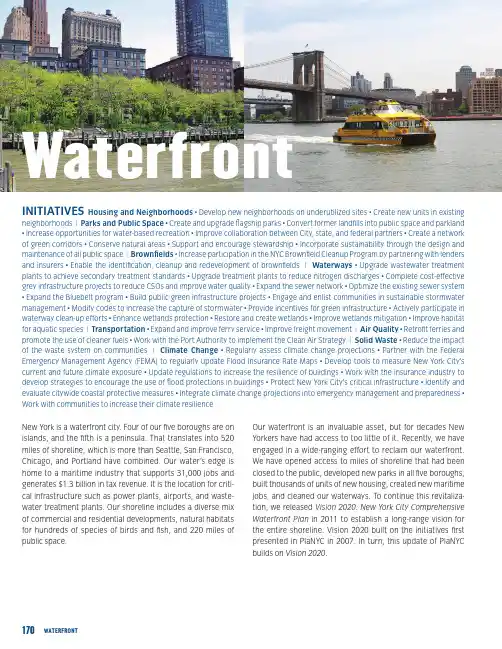
170WATERFRONTNew York is a waterfront city. Four of our five boroughs are on islands, and the fifth is a peninsula. That translates into 520 miles of shoreline, which is more than Seattle, San Francisco, Chicago, and Portland have combined. Our water’s edge is home to a maritime industry that supports 31,000 jobs and generates $1.3 billion in tax revenue. It is the location for criti-cal infrastructure such as power plants, airports, and waste-water treatment plants. Our shoreline includes a diverse mix of commercial and residential developments, natural habitats for hundreds of species of birds and fish, and 220 miles of public space.Our waterfront is an invaluable asset, but for decades New Yorkers have had access to too little of it. Recently, we have engaged in a wide-ranging effort to reclaim our waterfront. We have opened access to miles of shoreline that had been closed to the public, developed new parks in all five boroughs, built thousands of units of new housing, created new maritime jobs, and cleaned our waterways. To continue this revitaliza-tion, we released Vision 2020: New York City Comprehensive Waterfront Plan in 2011 to establish a long-range vision for the entire shoreline. Vision 2020 built on the initiatives first presented in PlaNYC in 2007. In turn, this update of PlaNYC builds on Vision 2020.INITIATIVES Housing and Neighborhoods • Develop new neighborhoods on underutilized sites • Create new units in existingneighborhoods | Parks and Public Space • Create and upgrade flagship parks • Convert former landfills into public space and parkland • Increase opportunities for water-based recreation • Improve collaboration between City, state, and federal partners • Create a network of green corridors • Conserve natural areas • Support and encourage stewardship • Incorporate sustainability through the design and maintenance of all public space | Brownfields • Increase participation in the NYC Brownfield Cleanup Program by partnering with lenders and insurers • Enable the identification, cleanup and redevelopment of brownfields | Waterways • Upgrade wastewater treatment plants to achieve secondary treatment standards • Upgrade treatment plants to reduce nitrogen discharges • Complete cost-effective grey infrastructure projects to reduce CSOs and improve water quality • Expand the sewer network • Optimize the existing sewer system • Expand the Bluebelt program • Build public green infrastructure projects • Engage and enlist communities in sustainable stormwater management • Modify codes to increase the capture of stormwater • Provide incentives for green infrastructure • Actively participate in waterway clean-up efforts • Enhance wetlands protection • Restore and create wetlands • Improve wetlands mitigation • Improve habitat for aquatic species | Transportation • Expand and improve ferry service • Improve freight movement | Air Quality • Retrofit ferries and promote the use of cleaner fuels • Work with the Port Authority to implement the Clean Air Strategy | Solid Waste • Reduce the impact of the waste system on communities | Climate Change • Regularly assess climate change projections • Partner with the Federal Emergency Management Agency (FEMA) to regularly update Flood Insurance Rate Maps • Develop tools to measure New York City’s current and future climate exposure • Update regulations to increase the resilience of buildings • Work with the insurance industry to develop strategies to encourage the use of flood protections in buildings • Protect New York City’s critical infrastructure • Identify and evaluate citywide coastal protective measures • Integrate climate change projections into emergency management and preparedness • Work with communities to increase their climate resilienceWe will enhance areas along the water and increase access to the water itself. By reducing Combined Sewer Overflows (CSOs), decreasing nitrogen discharges, removing contami-nated sediments, and restoring wetlands, we will strengthen our coastal ecosystems and provide more opportunities to use our waterways not only for people but for blue heron and bass as well. We will also transform underutilized areas along the water into destination parks in all five boroughs, includ-ing Brooklyn Bridge Park, Governors Island, Soundview Park, Rockaway Beach Park, and Freshkills Park.We will continue to enliven the waterfront with a range of attractive uses. We will build new residential neighborhoods at Hunter’s Point South and Willets Point. We will explore zoning changes for under-utilized areas to create opportunities for more productive uses. Development along our shores can help meet the need for housing and other services for a grow-ing population as well as provide jobs, generate tax revenues, and bring more people to the water. To make more under-utilized land available for redevelopment, we will implement programs to ensure a more effective process for cleaning up contaminated land.Our waterways will remain increasingly important blue high-ways for moving goods and people. An increase in water-borne transportation will relieve the burden on our streets and transit system. Ferry service on the East River will give more people a sustainable transportation alternative, while increas-ing tug-and-barge use to move solid waste out of the city will improve air quality and reduce congestion by taking trucks off the road. We will achieve cleaner air for waterfront communi-ties by increasing the use of cleaner fuels in maritime vessels and reducing emissions from the ships, trains, and trucks that use our ports.We will assess and respond to the impacts that sea level rise, storm surge, and increased precipitation levels will have on our coastal areas. By developing tools to measure New York City’s current and future climate risks, we will make more informed decisions in terms of how we design and adapt criti-cal pieces of coastal infrastructure and other elements of our built environment.Our effort to revitalize New York City’s waterfront extends beyond the initiatives in PlaNYC. Vision 2020 seeks not only to create new residential areas and parks where opportuni-ties exist but also to maintain a vibrant working waterfront where water-dependent industries can grow and thrive. We are developing waterfront infrastructure to enable the expan-sion of critical economic activities such as port commerce and shipping.Our waterfront is a crucial component of our physical, eco-nomic, and social fabric. We will revitalize our city’s edge to reconnect New Yorkers and visitors to the water and reclaim New York City’s standing as a premier waterfront city. With smart and sensitive planning, we will create a waterfront that will be cherished for generations to come.171A GREENER, GREATER NEW YORKPLANYC。
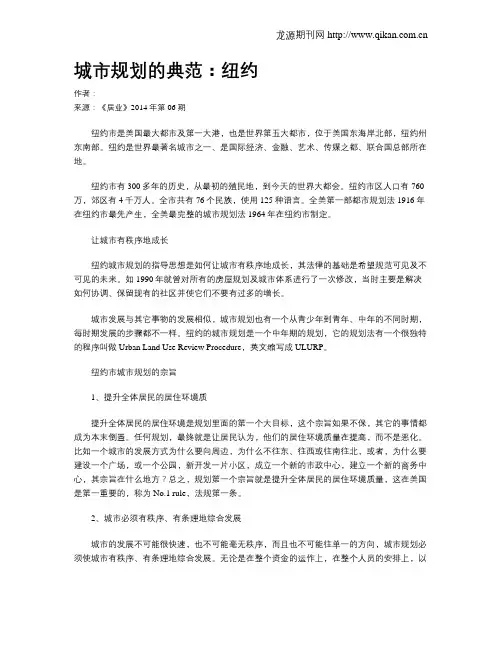
城市规划的典范:纽约作者:来源:《居业》2014年第06期纽约市是美国最大都市及第一大港,也是世界第五大都市,位于美国东海岸北部,纽约州东南部。
纽约是世界最著名城市之一、是国际经济、金融、艺术、传媒之都、联合国总部所在地。
纽约市有300多年的历史,从最初的殖民地,到今天的世界大都会。
纽约市区人口有760万,郊区有4千万人。
全市共有76个民族,使用125种语言。
全美第一部都市规划法1916年在纽约市最先产生,全美最完整的城市规划法1964年在纽约市制定。
让城市有秩序地成长纽约城市规划的指导思想是如何让城市有秩序地成长,其法律的基础是希望规范可见及不可见的未来。
如1990年就曾对所有的房屋规划及城市体系进行了一次修改,当时主要是解决如何协调、保留现有的社区并使它们不要有过多的增长。
城市发展与其它事物的发展相似,城市规划也有一个从青少年到青年、中年的不同时期,每时期发展的步骤都不一样。
纽约的城市规划是一个中年期的规划,它的规划法有一个很独特的程序叫做Urban Land Use Review Procedure,英文缩写成ULURP。
纽约市城市规划的宗旨1、提升全体居民的居住环境质提升全体居民的居住环境是规划里面的第一个大目标,这个宗旨如果不保,其它的事情都成为本末倒置。
任何规划,最终就是让居民认为,他们的居住环境质量在提高,而不是恶化。
比如一个城市的发展方式为什么要向周边,为什么不往东、往西或往南往北,或者,为什么要建设一个广场,或一个公园,新开发一片小区,成立一个新的市政中心,建立一个新的商务中心,其宗旨在什么地方?总之,规划第一个宗旨就是提升全体居民的居住环境质量,这在美国是第一重要的,称为No.1 rule,法规第一条。
2、城市必须有秩序、有条理地综合发展城市的发展不可能很快速,也不可能毫无秩序,而且也不可能往单一的方向,城市规划必须使城市有秩序、有条理地综合发展。
无论是在整个资金的运作上,在整个人员的安排上,以及在执法、执行、监督上都必须首先遵循这样的一个条件。
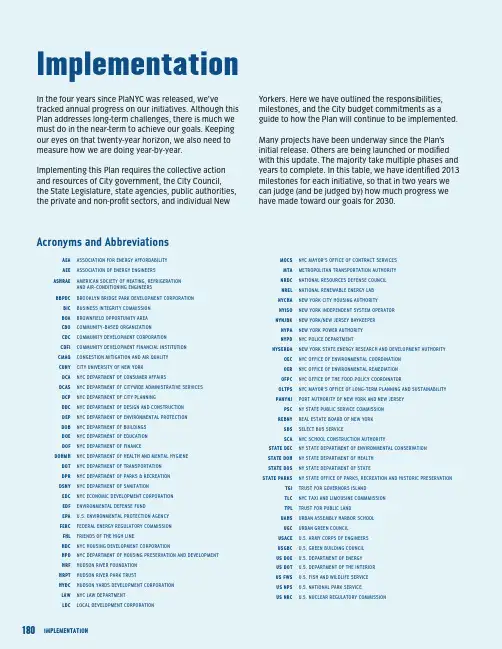
Implementation In the four years since PlaNYC was released, we’ve tracked annual progress on our initiatives. Although this Plan addresses long-term challenges, there is much we must do in the near-term to achieve our goals. Keeping our eyes on that twenty-year horizon, we also need to measure how we are doing year-by-year.Implementing this Plan requires the collective action and resources of City government, the City Council, the State Legislature, state agencies, public authorities, the private and non-profit sectors, and individual NewAEA ASSOCIATION FOR ENERGY AFFORDABILITYAEE ASSOCIATION OF ENERGY ENGINEERSASHRAE AMERICAN SOCIETY OF HEATING, REFRIGERATIONAND AIR-CONDITIONING ENGINEERSBBPDC BROOKLYN BRIDGE PARK DEVELOPMENT CORPORATION BIC BUSINESS INTEGRITY COMMISSIONBOA BROWNFIELD OPPORTUNITY AREACBO COMMUNITY-BASED ORGANIZATIONCDC COMMUNITY DEVELOPMENT CORPORATIONCDFI COMMUNITY DEVELOPMENT FINANCIAL INSTITUTIONCMAQ CONGESTION MITIGATION AND AIR QUALITYCUNY CITY UNIVERSITY OF NEW YORKDCA NYC DEPARTMENT OF CONSUMER AFFAIRSDCAS NYC DEPARTMENT OF CITYWIDE ADMINISTRATIVE SERVICESDCP NYC DEPARTMENT OF CITY PLANNINGDDC NYC DEPARTMENT OF DESIGN AND CONSTRUCTIONDEP NYC DEPARTMENT OF ENVIRONMENTAL PROTECTIONDOB NYC DEPARTMENT OF BUILDINGSDOE NYC DEPARTMENT OF EDUCATIONDOF NYC DEPARTMENT OF FINANCEDOHMH NYC DEPARTMENT OF HEALTH AND MENTAL HYGIENE DOT NYC DEPARTMENT OF TRANSPORTATIONDPR NYC DEPARTMENT OF PARKS & RECREATIONDSNY NYC DEPARTMENT OF SANITATIONEDC NYC ECONOMIC DEVELOPMENT CORPORATIONEDF ENVIRONMENTAL DEFENSE FUNDEPA U.S. ENVIRONMENTAL PROTECTION AGENCYFERC FEDERAL ENERGY REGULATORY COMMISSIONFHL FRIENDS OF THE HIGH LINEHDC NYC HOUSING DEVELOPMENT CORPORATIONHPD NYC DEPARTMENT OF HOUSING PRESERVATION AND DEVELOPMENT HRF HUDSON RIVER FOUNDATIONHRPT HUDSON RIVER PARK TRUSTHYDC HUDSON YARDS DEVELOPMENT CORPORATIONLAW NYC LAW DEPARTMENTLDC LOCAL DEVELOPMENT CORPORATIONMOCS NYC MAYOR’S OFFICE OF CONTRACT SERVICESMTA METROPOLITAN TRANSPORTATION AUTHORITYNRDC NATIONAL RESOURCES DEFENSE COUNCILNREL NATIONAL RENEWABLE ENERGY LABNYCHA NEW YORK CITY HOUSING AUTHORITYNYISO NEW YORK INDEPENDENT SYSTEM OPERATORNYNjBK NEW YORK/NEW jERSEY BAYKEEPERNYPA NEW YORK POWER AUTHORITYNYPD NYC POLICE DEPARTMENTNYSERDA NEW YORK STATE ENERGY RESEARCH AND DEVELOPMENT AUTHORITY OEC NYC OFFICE OF ENVIRONMENTAL COORDINATIONOER NYC OFFICE OF ENVIRONMENTAL REMEDIATIONOFPC NYC OFFICE OF THE FOOD POLICY COORDINATOROLTPS NYC MAYOR’S OFFICE OF LONG-TERM PLANNING AND SUSTAINABILITYPANYNj PORT AUTHORITY OF NEW YORK AND NEW jERSEYPSC NY STATE PUBLIC SERVICE COMMISSIONREBNY REAL ESTATE BOARD OF NEW YORKSBS SELECT BUS SERVICESCA NYC SCHOOL CONSTRUCTION AUTHORITYSTATE DEC NY STATE DEPARTMENT OF ENVIRONMENTAL CONSERVATIONSTATE DOH NY STATE DEPARTMENT OF HEALTHSTATE DOS NY STATE DEPARTMENT OF STATESTATE PARKS NY STATE OFFICE OF PARKS, RECREATION AND HISTORIC PRESERVATION TGI TRUST FOR GOVERNORS ISLANDTLC NYC TAxI AND LIMOUSINE COMMMISSIONTPL TRUST FOR PUBLIC LANDUAHS URBAN ASSEMBLY HARBOR SCHOOLUGC URBAN GREEN COUNCILUSACE U.S. ARMY CORPS OF ENGINEERSUSGBC U.S. GREEN BUILDING COUNCILUS DOE U.S. DEPARTMENT OF ENERGYUS DOT U.S. DEPARTMENT OF THE INTERIORUS FWS U.S. FISH AND WILDLIFE SERVICEUS NPS U.S. NATIONAL PARK SERVICEUS NRC U.S. NUCLEAR REGULATORY COMMISSIONYorkers. Here we have outlined the responsibilities, milestones, and the City budget commitments as a guide to how the Plan will continue to be implemented. Many projects have been underway since the Plan’s initial release. Others are being launched or modified with this update. The majority take multiple phases and years to complete. In this table, we have identified 2013 milestones for each initiative, so that in two years we can judge (and be judged by) how much progress we have made toward our goals for 2030.Acronyms and Abbreviations。

纽约、东京最新总体规划指标体系介绍提到城市总体规划指标体系,我们脑海中可以马上浮现出一系列名词:GDP总量,人均GDP,人均建设用地面积,单位工业用地增加值,单位GDP能耗……这些熟悉的词汇已经伴随在我们身边多年。
然而在当前的“新常态”下,探索城市发展方式的转型成为规划工作的新主线,我们突然发现,大家纷纷开始“不看GDP”了,原来的那一整套指标也似乎不再完美适用了。
那么问题来了:今天的我们该看什么、能看什么呢?总体规划指标体系是反映城市总体规划目标的量化衡量工具,是增强规划可操作性和指导规划实施的抓手,也是评估考核规划实现状况和程度的主要方法之一。
总体规划指标体系的设计最重要的是考量其与总体规划目标的对应性,用哪些指标来衡量我们为城市设立的特定发展目标才是恰如其分的?显然,发展目标不同,相应的衡量指标也应该有所不同,例如一个服务业主导的城市有必要将单位工业用地增加值列入核心规划指标吗?即使实现了规划值也无法说明该城市的发展与其规划目标的契合。
因此,一个指标体系用之四海的时代也该退场了,也许我们都需要为自己的城市重新量身定做合体、简洁、适应新的发展特征、更能指导实施的总体规划指标体系。
纽约和东京相继在最近颁布了新的城市规划,他们有什么最新动向和关注焦点,或许能给我们一些启发。
让我们看看这两个国际大都市为自己勾画了怎样的蓝图,又给自己立下了怎样的规划指标“投名状”吧。
图 1 《一个纽约——规划一个强大而公正的城市》/《创造未来——东京都长期展望》封面因篇幅有限,下文仅列出纽约和东京规划文件中的主要规划指标。
针对部分现状数据,本文还加入了北京的数据作为对比,以使我们可以较为直观地感受该城市在某项指标上已达到什么样的水平、规划期望值有多高。
纽约市2015年4月发布的《一个纽约——规划一个强大而公正的城市》主要面向2040年提出了四项发展愿景,规划总人口由840万增至900万。
以下指标数据未标明年份的皆为起始年份2014年,目标年份2040年:愿景一我们成长中的繁荣城市图 2 2014-2025主要城市及地区资金项目计划1.纽约市有成为全球经济领导者的空间与资本,可以提供高品质多元化的就业:就业岗位由416.6万增至489.6万;创新产业就业岗位比重由15%增至20%;家庭收入中位数在52250美元基础上有所增加(北京2014年人均家庭总收入为49730元);GDP增长高于全国平均水平(2014年为6470亿美元,北京同期为3438.5亿美元)。
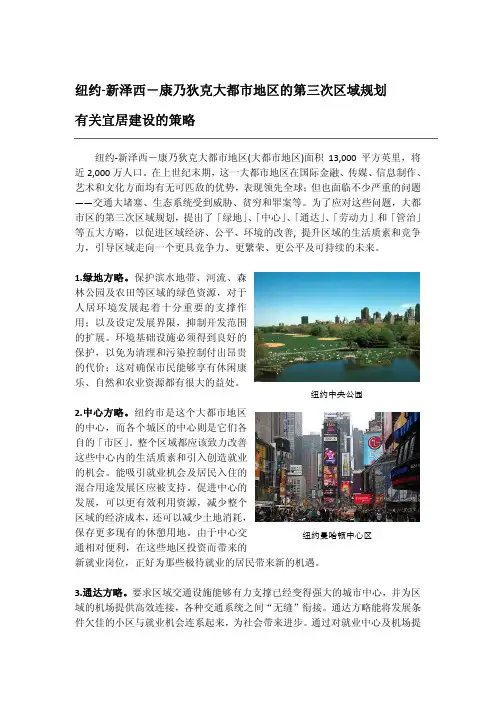
纽约‐新泽西-康乃狄克大都市地区的第三次区域规划 有关宜居建设的策略纽约‐新泽西-康乃狄克大都市地区(大都市地区)面积13,000平方英里,将近2,000万人口。
在上世纪末期,这一大都市地区在国际金融、传媒、信息制作、艺术和文化方面均有无可匹敌的优势,表现领先全球;但也面临不少严重的问题——交通大堵塞、生态系统受到威胁、贫穷和罪案等。
为了应对这些问题,大都市区的第三次区域规划,提出了「绿地」、「中心」、「通达」、「劳动力」和「管治」等五大方略,以促进区域经济、公平、环境的改善, 提升区域的生活质素和竞争力,引导区域走向一个更具竞争力、更繁荣、更公平及可持续的未来。
1.绿地方略。
保护滨水地带、河流、森林公园及农田等区域的绿色资源,对于人居环境发展起着十分重要的支撑作用;以及设定发展界限,抑制开发范围的扩展。
环境基础设施必须得到良好的保护,以免为清理和污染控制付出昂贵的代价;这对确保市民能够享有休闲康乐、自然和农业资源都有很大的益处。
2.中心方略。
纽约市是这个大都市地区的中心,而各个城区的中心则是它们各自的「市区」。
整个区域都应该致力改善这些中心内的生活质素和引入创造就业的机会。
能吸引就业机会及居民入住的混合用途发展区应被支持。
促进中心的发展,可以更有效利用资源,减少整个区域的经济成本,还可以减少土地消耗,保存更多现有的休憩用地。
由于中心交通相对便利,在这些地区投资而带来的新就业岗位,正好为那些极待就业的居民带来新的机遇。
3.通达方略。
要求区域交通设施能够有力支撑已经变得强大的城市中心,并为区域的机场提供高效连接,各种交通系统之间“无缝”衔接。
通达方略能将发展条件欠佳的小区与就业机会连系起来,为社会带来进步。
通过对就业中心及机场提纽约中央公园纽约曼哈顿中心区供便捷的交通服务、改造过时的货运系统、以及减少挤塞的道路网络,可以增强区域的经济实力。
4.劳动力方略。
要呼吁区域内的企业、市民、地方政府构筑终身学习的体系,确保劳动力持续地符合经济的需求。
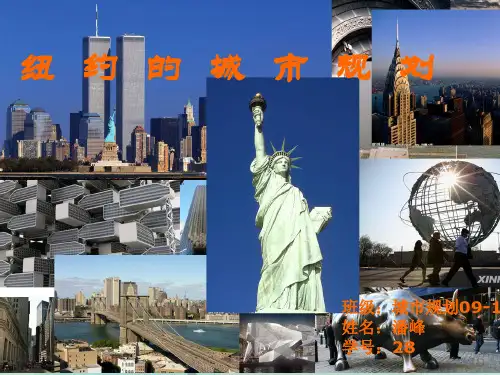
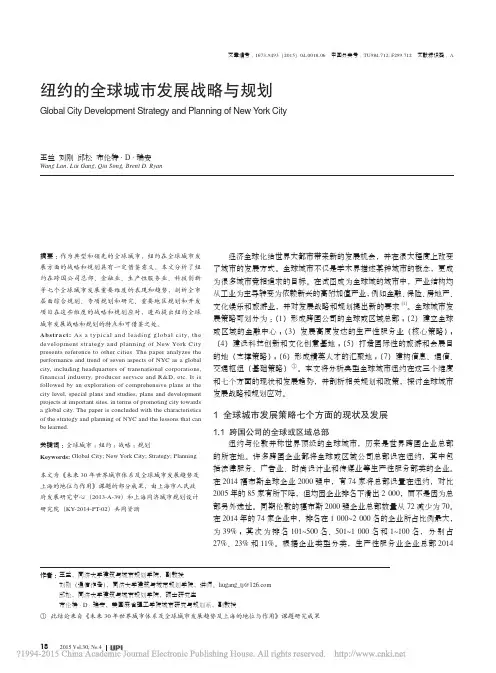
Global City Development Strategy and Planning of New Y ork City纽约的全球城市发展战略与规划王兰 刘刚 邱松 布伦特·D ·瑞安Wang Lan, Liu Gang, Qiu Song, Brent D. Ryan文章编号:1673-9493(2015)04-0018-06 中图分类号:TU984.712; F299.712 文献标识码:A经济全球化给世界大都市带来新的发展机会,并在很大程度上改变了城市的发展方式。
全球城市不仅是学术界描述某种城市的概念,更成为很多城市竞相追求的目标。
在试图成为全球城的城市中,产业结构均从工业为主导转变为依赖新兴的高附加值产业,例如金融、保险、房地产、文化娱乐和旅游业,并对发展战略和规划提出新的要求[1]。
全球城市发展策略可划分为:(1)形成跨国公司的全球或区域总部;(2)建立全球或区域的金融中心;(3)发展高度发达的生产性服务业(核心策略);(4)建设科技创新和文化创意基地;(5)打造国际性的旅游和会展目的地(支撑策略);(6)形成精英人才的汇聚地;(7)建构信息、通信、交通枢纽(基础策略)①。
本文将分析典型全球城市纽约在这三个维度和七个方面的现状和发展趋势,并剖析相关规划和政策,探讨全球城市发展战略和规划应对。
1 全球城市发展策略七个方面的现状及发展1.1 跨国公司的全球或区域总部纽约与伦敦并称世界顶级的全球城市,历来是世界跨国企业总部的所在地。
许多跨国企业都将全球或区域公司总部设在纽约,其中包括法律服务、广告业、时尚设计业和传媒业等生产性服务部类的企业。
在2014福布斯全球企业2000强中,有74家将总部设置在纽约,对比2005年的85家有所下降,但均因企业排名下滑出2 000,而不是因为总部另外选址。
同期伦敦的福布斯2000强企业总部数量从72减少为70。
在2014年的74家企业中,排名在1 000~2 000名的企业所占比例最大,为39%;其次为排名101~500名、501~1 000名和1~100名,分别占27%、23%和11%。
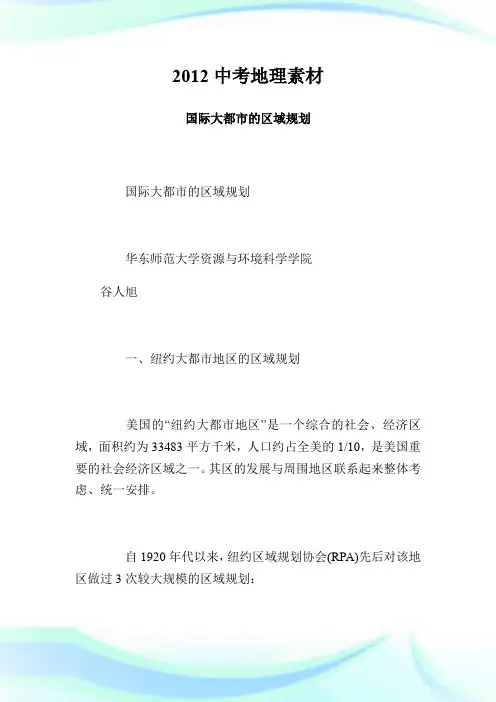
2012中考地理素材国际大都市的区域规划国际大都市的区域规划华东师范大学资源与环境科学学院谷人旭一、纽约大都市地区的区域规划美国的“纽约大都市地区”是一个综合的社会、经济区域,面积约为33483平方千米,人口约占全美的1/10,是美国重要的社会经济区域之一。
其区的发展与周围地区联系起来整体考虑、统一安排。
自1920年代以来,纽约区域规划协会(RPA)先后对该地区做过3次较大规模的区域规划:1921~1929年的第一次规划,RPA便确定了十项政策和规定:①通过区域(regionalzoning)指导地方规划(localzoningplan);②建立特殊的楔形农业用地,提供更多的开放空间,而不是公园和森林保护区;③为减轻交通拥塞,新的交通设施应注重整体性效果;④疏散那些与中心区位关系不大的活动,集聚那些不能疏散的功能,保持区域整体性;⑤高层建筑由于产生拥塞与交通需求等公共损失,一般是不可取的;⑥需要有更多的公共开放空间,特别是河流和港口边缘;⑦未来机场需要有大块土地;⑧设计要进一步细化,落实到具体区位;⑨系统地减少工业发达与不发达的城镇间不公正的财产税;⑩建立开发公司来促进工业布局调整与卫星城建设。
这次规划的核心是“再中心化”。
规划提出用环路系统来鼓励建设一个理想的都市景观:办公室从中心城市(曼哈顿)疏散出去;工业布置在沿着主要的郊区交通枢纽的工业园中;居住向整个地区扩散,而不是形成密集的邻里;这样,留出来的许多空地作为开放空间,吸引白领阶层到该区来生活。
这一规划设想促使区域共同建立公路网、铁路网以及公园体系,这为后来区域发展提供了框架。
由于种种原因,演进中的纽约大都市地区并没有实现再中心化。
二战后,以公路建设为先导,低密度的郊区在纽约大都市地区迅速蔓延,形成一种典型的美国式的发展,RPA称之为“铺开的城市”。
RPA认为,如果没有规划,将造成不良的后果:铺开的城市意味着要延长通勤者的往返路程,形成一个被隔离的社会,缺乏大城市区域应提供的公共设施和交通运输设施,以及缺乏一个明确的公共中心,有一种脱离自然和乡村的感觉。

170WATERFRONTNew York is a waterfront city. Four of our five boroughs are on islands, and the fifth is a peninsula. That translates into 520 miles of shoreline, which is more than Seattle, San Francisco, Chicago, and Portland have combined. Our water’s edge is home to a maritime industry that supports 31,000 jobs and generates $1.3 billion in tax revenue. It is the location for criti-cal infrastructure such as power plants, airports, and waste-water treatment plants. Our shoreline includes a diverse mix of commercial and residential developments, natural habitats for hundreds of species of birds and fish, and 220 miles of public space.Our waterfront is an invaluable asset, but for decades New Yorkers have had access to too little of it. Recently, we have engaged in a wide-ranging effort to reclaim our waterfront. We have opened access to miles of shoreline that had been closed to the public, developed new parks in all five boroughs, built thousands of units of new housing, created new maritime jobs, and cleaned our waterways. To continue this revitaliza-tion, we released Vision 2020: New York City Comprehensive Waterfront Plan in 2011 to establish a long-range vision for the entire shoreline. Vision 2020 built on the initiatives first presented in PlaNYC in 2007. In turn, this update of PlaNYC builds on Vision 2020.INITIATIVES Housing and Neighborhoods • Develop new neighborhoods on underutilized sites • Create new units in existingneighborhoods | Parks and Public Space • Create and upgrade flagship parks • Convert former landfills into public space and parkland • Increase opportunities for water-based recreation • Improve collaboration between City, state, and federal partners • Create a network of green corridors • Conserve natural areas • Support and encourage stewardship • Incorporate sustainability through the design and maintenance of all public space | Brownfields • Increase participation in the NYC Brownfield Cleanup Program by partnering with lenders and insurers • Enable the identification, cleanup and redevelopment of brownfields | Waterways • Upgrade wastewater treatment plants to achieve secondary treatment standards • Upgrade treatment plants to reduce nitrogen discharges • Complete cost-effective grey infrastructure projects to reduce CSOs and improve water quality • Expand the sewer network • Optimize the existing sewer system • Expand the Bluebelt program • Build public green infrastructure projects • Engage and enlist communities in sustainable stormwater management • Modify codes to increase the capture of stormwater • Provide incentives for green infrastructure • Actively participate in waterway clean-up efforts • Enhance wetlands protection • Restore and create wetlands • Improve wetlands mitigation • Improve habitat for aquatic species | Transportation • Expand and improve ferry service • Improve freight movement | Air Quality • Retrofit ferries and promote the use of cleaner fuels • Work with the Port Authority to implement the Clean Air Strategy | Solid Waste • Reduce the impact of the waste system on communities | Climate Change • Regularly assess climate change projections • Partner with the Federal Emergency Management Agency (FEMA) to regularly update Flood Insurance Rate Maps • Develop tools to measure New York City’s current and future climate exposure • Update regulations to increase the resilience of buildings • Work with the insurance industry to develop strategies to encourage the use of flood protections in buildings • Protect New York City’s critical infrastructure • Identify and evaluate citywide coastal protective measures • Integrate climate change projections into emergency management and preparedness • Work with communities to increase their climate resilienceWe will enhance areas along the water and increase access to the water itself. By reducing Combined Sewer Overflows (CSOs), decreasing nitrogen discharges, removing contami-nated sediments, and restoring wetlands, we will strengthen our coastal ecosystems and provide more opportunities to use our waterways not only for people but for blue heron and bass as well. We will also transform underutilized areas along the water into destination parks in all five boroughs, includ-ing Brooklyn Bridge Park, Governors Island, Soundview Park, Rockaway Beach Park, and Freshkills Park.We will continue to enliven the waterfront with a range of attractive uses. We will build new residential neighborhoods at Hunter’s Point South and Willets Point. We will explore zoning changes for under-utilized areas to create opportunities for more productive uses. Development along our shores can help meet the need for housing and other services for a grow-ing population as well as provide jobs, generate tax revenues, and bring more people to the water. To make more under-utilized land available for redevelopment, we will implement programs to ensure a more effective process for cleaning up contaminated land.Our waterways will remain increasingly important blue high-ways for moving goods and people. An increase in water-borne transportation will relieve the burden on our streets and transit system. Ferry service on the East River will give more people a sustainable transportation alternative, while increas-ing tug-and-barge use to move solid waste out of the city will improve air quality and reduce congestion by taking trucks off the road. We will achieve cleaner air for waterfront communi-ties by increasing the use of cleaner fuels in maritime vessels and reducing emissions from the ships, trains, and trucks that use our ports.We will assess and respond to the impacts that sea level rise, storm surge, and increased precipitation levels will have on our coastal areas. By developing tools to measure New York City’s current and future climate risks, we will make more informed decisions in terms of how we design and adapt criti-cal pieces of coastal infrastructure and other elements of our built environment.Our effort to revitalize New York City’s waterfront extends beyond the initiatives in PlaNYC. Vision 2020 seeks not only to create new residential areas and parks where opportuni-ties exist but also to maintain a vibrant working waterfront where water-dependent industries can grow and thrive. We are developing waterfront infrastructure to enable the expan-sion of critical economic activities such as port commerce and shipping.Our waterfront is a crucial component of our physical, eco-nomic, and social fabric. We will revitalize our city’s edge to reconnect New Yorkers and visitors to the water and reclaim New York City’s standing as a premier waterfront city. With smart and sensitive planning, we will create a waterfront that will be cherished for generations to come.171A GREENER, GREATER NEW YORKPLANYC。
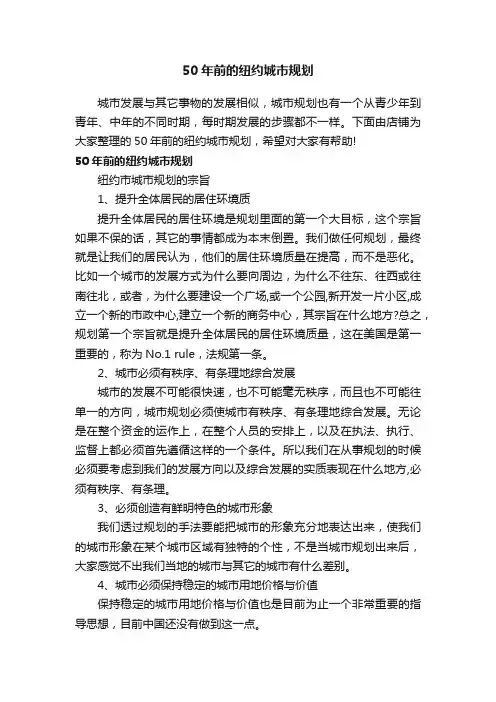
50年前的纽约城市规划城市发展与其它事物的发展相似,城市规划也有一个从青少年到青年、中年的不同时期,每时期发展的步骤都不一样。
下面由店铺为大家整理的50年前的纽约城市规划,希望对大家有帮助!50年前的纽约城市规划纽约市城市规划的宗旨1、提升全体居民的居住环境质提升全体居民的居住环境是规划里面的第一个大目标,这个宗旨如果不保的话,其它的事情都成为本末倒置。
我们做任何规划,最终就是让我们的居民认为,他们的居住环境质量在提高,而不是恶化。
比如一个城市的发展方式为什么要向周边,为什么不往东、往西或往南往北,或者,为什么要建设一个广场,或一个公园,新开发一片小区,成立一个新的市政中心,建立一个新的商务中心,其宗旨在什么地方?总之,规划第一个宗旨就是提升全体居民的居住环境质量,这在美国是第一重要的,称为No.1 rule,法规第一条。
2、城市必须有秩序、有条理地综合发展城市的发展不可能很快速,也不可能毫无秩序,而且也不可能往单一的方向,城市规划必须使城市有秩序、有条理地综合发展。
无论是在整个资金的运作上,在整个人员的安排上,以及在执法、执行、监督上都必须首先遵循这样的一个条件。
所以我们在从事规划的时候必须要考虑到我们的发展方向以及综合发展的实质表现在什么地方,必须有秩序、有条理。
3、必须创造有鲜明特色的城市形象我们透过规划的手法要能把城市的形象充分地表达出来,使我们的城市形象在某个城市区域有独特的个性,不是当城市规划出来后,大家感觉不出我们当地的城市与其它的城市有什么差别。
4、城市必须保持稳定的城市用地价格与价值保持稳定的城市用地价格与价值也是目前为止一个非常重要的指导思想,目前中国还没有做到这一点。
土地是很宝贵的资源,土地与市政建设开发以及与建设的发展方向也有相对的关系。
中国的土地将来能够变成一种商品,变成一种价值。
在社会主义的构架下,必须把中国的土地当成一个投资,做成一种商品,使土地的价格与价值能够稳定地发展。
178SUSTAINABILITY INDICATORSIf we are going to meet our goals in 2030, we need to track our progress every step along the way. Since the launch of PlaNYC in 2007 we have been transparent and accountable, issuing annual reports on whatmilestones we have accomplished—and just as candidly reporting on those milestones that have not yet been accomplished.This update to PlaNYC contains over 400 milestones to be met by December 31, 2013, pointing the way to our ultimate goals for the year 2030. We will continue to issue annual findings on our progress, using these milestones as our measure.Sustainability IndicatorsWe have also identified 29 Sustainability Indicators which we use to track our progress toward our long-term goals. These indicators are designed to provide a quantifiable bellweather for each component of a PlaNYC goal, so that one can tell, for example, if we are achieving one part of a goal but not another.The indicators help us assess whether changes to the plan are needed and are part of our ongoing commitment to transparency and accountability. The Sustainability Indicators are a subset of the New York City Department of Health and Mental Hygiene’s Environmental Public Health Tracking Portal.1 Results are a snapshot taken in March 20112 Results are for FY or CY 20103 Results are for FY or CY 2009, data is only available with a lag4 Resuts are for CY 2008, data comes from HVS a triennial survey179A GREENER, GREATER NEW YORK PLANYC。
纽约五大行政区经济发展战略纽约市长布隆伯格在纽约市地产委员会议上做了《纽约五大行政区经济发展战略》的讲话指出,构成纽约发展战略的三大要素是:更适宜居住的城市、日趋多样化的经济架构、商务友好的环境与氛围。
他在发言中一再强调,保证纽约长期繁荣必须均衡五个行政区的经济发展,减少对单一区域(华尔街)的依赖;政府实施该战略必须为所有纽约人创造就业和机遇。
一、更适宜居住的城市1.适宜居住的首要条件是安全,它是创造机遇的基础犯罪率:2004年期间,谋杀案件为1963年以来的最低,而且,该年又进一步下降了17%。
在纽约市行政当局的努力下,纽约市五个区的犯罪率在持续不断地普遍下降,使其成为全美最安全的大城市。
记录显示,过去四年间,布鲁克斯区的谋杀案下降了52%,皇后区的入室盗窃下降30%,而斯坦顿岛的汽车偷盗案下降54%。
防火:2004年纽约火灾死亡人数为85年来最低。
交通事故造成的行人和驾乘人员伤亡则是1919年以来的最低点。
2. 为纽约人保留买得起的住房80年代中期以来,纽约五大行政区为20万纽约人建造与维护他们买得起的住房。
纽约市最大的住房计划,总金额30亿美元,目标是为人们可以承受的住房。
纽约市还将创立20多英亩新公园和开放空间,以及14000套公寓,包括为中低收入纽约人提供成几千套平价单元住房。
3.娱乐、刺激和有创造性活动及场所今年2月份全球有成百上千人成群结队地来参观“门廊-The Gates”。
虽然这个时间通常是年中旅游淡季,但整个城市的酒店客房出租率大大高于正常水平,饭店也挤满了招待和记者,犹如“二月里的圣诞节”。
参观博物馆和文化景观,观看百老汇演出的人数直线上升,接待游客的商店也生意兴隆。